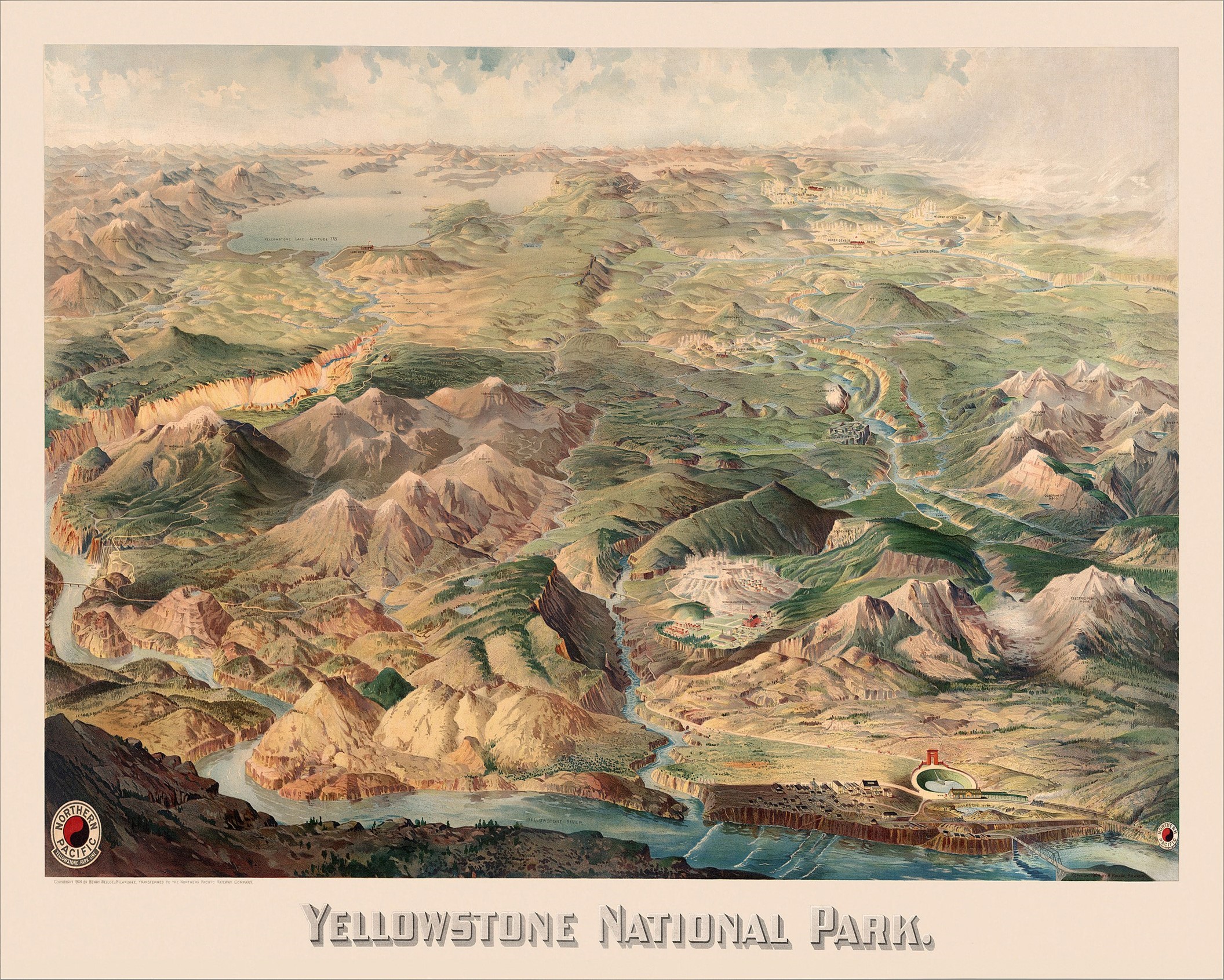
Credit: Henry Wellge (1850–1917), public domain, via Wikimedia Commons
Yellowstone was the first national park in the world, designated by the U.S. government in 1872.
Before then, it was travelled by explorers and fur trappers. And for 11,000 years before that was a hunting and camping ground for indigenous tribes.
But perhaps the most fascinating part of its history occurred when it was formed.
When you visit Yellowstone, you’re standing above a geologic hot spot in the Earth’s mantle.
Two million years ago, this hot spot created supercharged lava, in magma chambers that eventually erupted, launching volcanic material all the way to the Mississippi River.
The empty chambers then collapsed, forming the first Yellowstone Caldera, a 30-mile-wide shallow crater-basin.
Two more volcanic eruptions happened, 1.3 million and 600,000 years ago, such that three overlapping calderas about 45 miles wide form the center of Yellowstone Park.
Though the calderas have gradually filled with sediment, they’re still home to more than half of the world’s geysers and natural hot spring pools.
Except for its remarkable hydrothermal activity, Yellowstone has been volcanically quiet for 70,000 years—and scientists don’t expect it to erupt again in our lifetimes. Some think it may never.
Still, the park remains one of the most heavily instrumented and closely monitored sites in the world, a geologic wonder that amazes scientists—and millions of visitors each year.
Background
Synopsis: Iconic Yellowstone National Park protects one of the most unique geological systems on Earth’s surface and the ecosystem associated with it. Its origin story is remarkable, and its history is compelling as the first national park designated in the United States—and the world.
- Yellowstone National Park covers more than 2.2 million acres (3,468 mi2 or 8,983 km2) of northwestern Wyoming, just lapping over the state borders into Idaho and Montana. It is an area about the size of the islands of Puerto Rico or Cyprus.
- Yellowstone is most famous for its geothermal features, including geysers like Old Faithful, fumaroles like the Black Growler Steam Vent, hot springs like the Grand Prismatic Spring, and bubbling mudpots like the Artist Paint Pots. Over half of the world’s geysers and hydrothermal features are in Yellowstone.
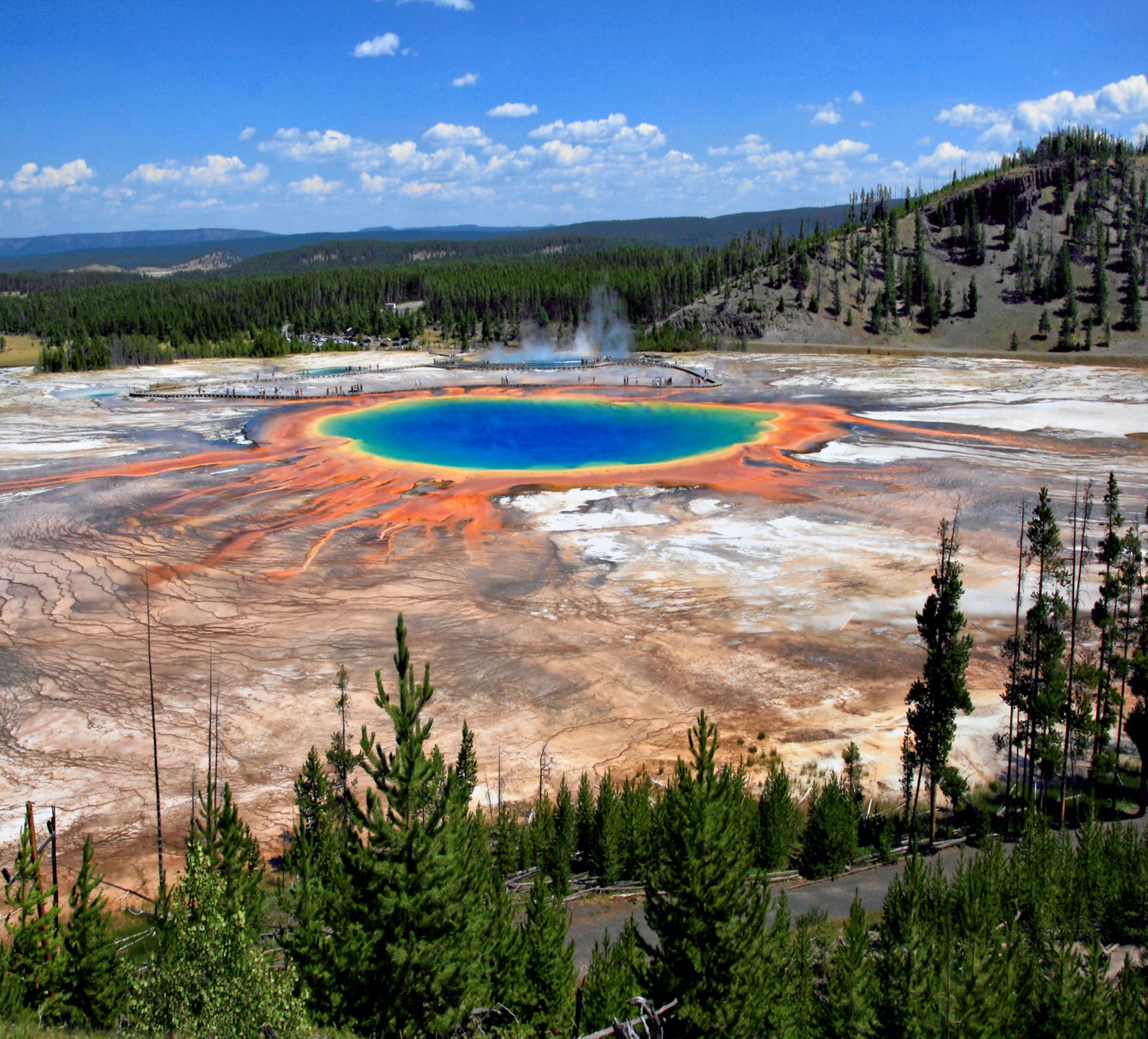
The Grand Prismatic Spring in Yellowstone National Park is the largest hot spring in the United States with a diameter of 370 feet (110 meters) and a depth of 160 feet (50 meters), discharging 560 gallons (2,100 liters) of 160°F (70°C) water per minute. It was named by geologists working in the Hayden Geological Survey of 1871 because of its vivid coloring that comes from algal mats along its edges.
Credit: Brocken Inaglory, via Wikimedia Commons - Yellowstone Lake is one of the largest high elevation lakes in North America and is located within the Yellowstone Caldera, the largest volcanic complex on the North American continent.
- Volcanic rocks and lava flows cover most of the park’s ground surface.
- It is home to wildlife including elk, antelope, bison, bears and wolves of the Greater Yellowstone Ecosystem, the largest mostly intact northern temperate zone ecosystem.
- In 1978, Yellowstone National Park was named a UNESCO World Heritage Site.
- In 2021, about 4.86 million people visited the park with its 9 hotels, 11 visitor centers and 466 mi (750 km) of roads.
- Yellowstone is most famous for its geothermal features, including geysers like Old Faithful, fumaroles like the Black Growler Steam Vent, hot springs like the Grand Prismatic Spring, and bubbling mudpots like the Artist Paint Pots. Over half of the world’s geysers and hydrothermal features are in Yellowstone.
- On March 1, 1872, the park was established when President Ulysses S. Grant signed the Yellowstone National Park Protection Act into law, making it the first national park in the United States and the world.
- The park probably gets its name from yellow rocks exposed in its Grand Canyon.
- Native Americans hunted and fished in the park for at least 11,000 years, leaving behind thousands of archaeological sites. They knapped Clovis points from local obsidian that were traded as far away as Ontario.
- French trappers and American mountain men explored the park in the late 1700’s and early 1800’s, but organized exploration did not start until after the Civil War when a couple of expeditions documented sites and collected specimens.
- Several explorers suggested the “Great Geyser Basin” be preserved, leading Ferdinand Hayden to return to the region with his Geological Survey of 1871, producing maps and paintings and taking photos that convinced the 42nd U.S. Congress to send the 1872 act to the president’s desk.
- The Army administered the park from 1886 to 1916 until the National Park Service was formed in 1917 and took over its administration.
- From 1933 to 1942, the Civilian Conservation Corps (CCC) developed campgrounds, trails, roads and the early park visitor centers.
- From a geological standpoint, the 30 to 45 mi (50–70 km) diameter Yellowstone Caldera Complex is a very young system, made up of three caldera complexes that were formed 2.1, 1.3 and 0.63 million years ago.
- Yellowstone occurs at the youngest, northeasternmost end of a long track of volcanism that began 16.5 million years ago to form the Snake River Basalt.
- While most volcanic complexes occur near the edges of tectonic plates, Yellowstone’s three overlapping volcanic calderas are located within a large continent with a mantle hot spot as a heat source.
- Although it appears that the underlying heat source is moving to the northeast, it is actually the North American Plate that is moving to the southwest over the static heat source at a rate of about 1.8 in (4.6 cm) per year.
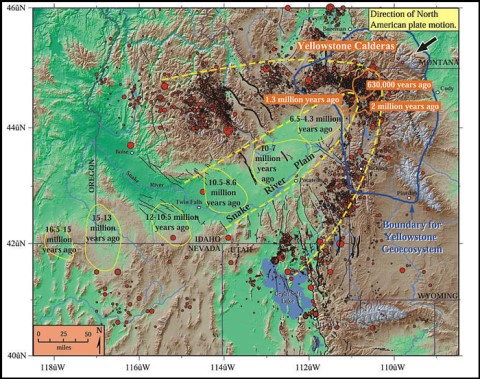
Map showing the trail of calderas left behind by volcanic activity that started 16.5 million years ago at the Oregon–Idaho–Nevada border and continued 465 miles (750 kilometers) northeastward into the Yellowstone region through about 630,000 years ago.
Credit: USGS - Scientists are still working out whether the hot spot extends to Earth’s core, like the Hawaiian Islands hot spot, or is more likely a mantle response to plate subduction along western North America about 50 million years ago.
- Magma chambers in the southwestern part of today’s park filled 2.1 million years ago, producing one of Earth’s largest volcanic “super eruptions.”
- It ejected ash and volcanic debris that landed as far away as the Mississippi River Valley–more than 6,000 times the debris produced at Mount St Helens.
- Then the empty magma reservoir collapsed to form a caldera.
- Then lava flows and minor eruptions occurred along caldera faults.
- The same super eruption sequence happened twice again 1.3 million and 630,000 years ago, but volumes were just 11% and 40% of the 2.1 million year eruption, respectively.
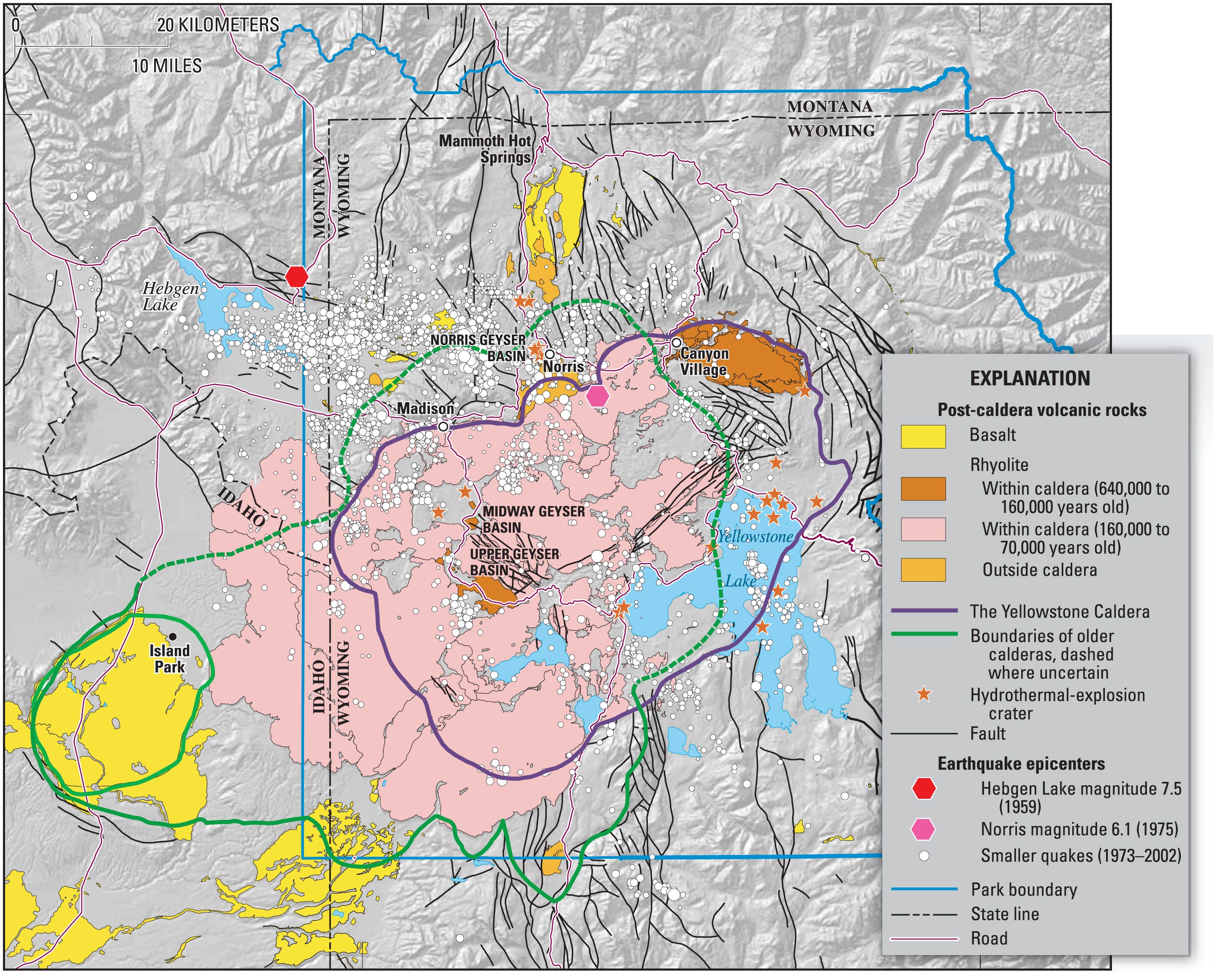
A map of the overlapping calderas, lava flows and potential hazards of Yellowstone, including earthquakes and hydrothermal explosion craters.
Credit: USGS - The most recent explosive activity at Yellowstone was in the West Thumb Lake area 174,000 years ago, while the most recent basaltic lava flow occurred at the Pitchstone Plateau 70,000 years ago, vestiges of the event 630,000 years ago.
- In the past 70,000 years, the complex has been quiet, except for hydrothermal activity as groundwater interacts geothermally as described in ED-031 Under Pressure—Geysers.
- Clogs in geothermal systems can cause hydrothermal explosions that may create craters, and these occur every year.
- Experts explain that any future volcanic activity would most likely be a localized lava flow, but probably not in our lifetimes.
- Of more concern would be earthquake activity like the 1959 magnitude 7.3 quake that caused a landslide that dammed the Madison River to form Quake Lake.
- While geological rumblings in the park get a lot of press, the chance of a dangerous future eruption is very small.
- Seismic studies show us that the Yellowstone system has two stacked magma chambers with just 5–15% of molten material.
- Volcanoes only erupt when enough eruptable magma is present, and that means about 50% molten material.
- If the magma chambers were to begin filling with molten material, we would see earthquakes, ground deformation, and thermal and gas emissions increasing for decades to centuries.
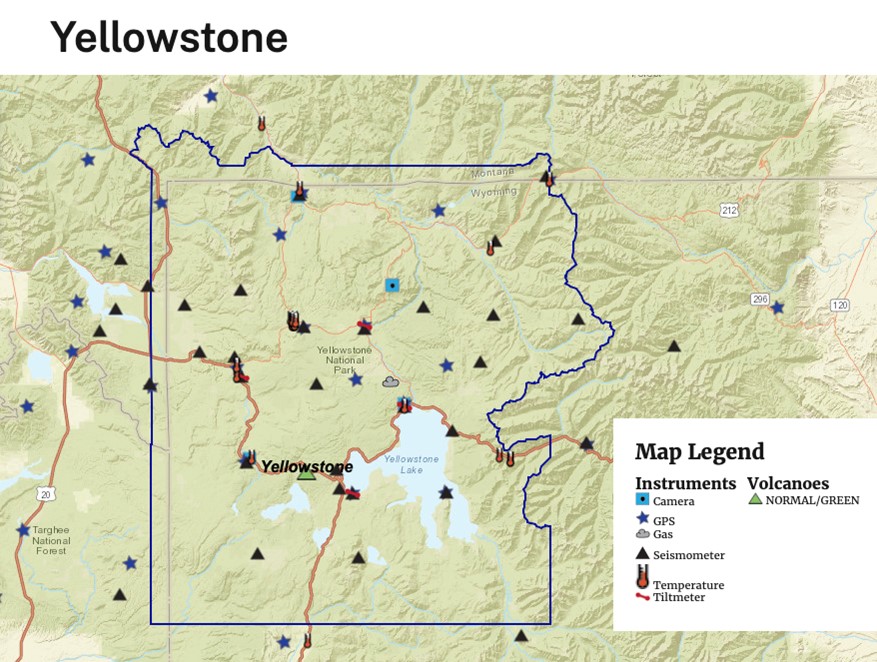
Instruments used in the USGS Yellowstone Volcano Observatory
Credit: USGS - Yellowstone is one of the best monitored volcanic complexes on Earth, with seismometers, GPS, tiltmeters, satellite monitoring, and gas and thermal sensors.
- When will it erupt? Experts say it could occur within a million years, or never again, as the thicker Beartooth Plateau rides over the mantle plume. Scientists aren’t sure what will happen since this will occur over the next 5 million years.

